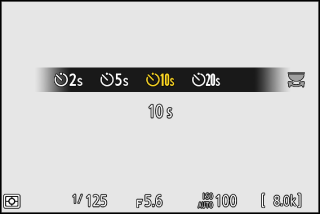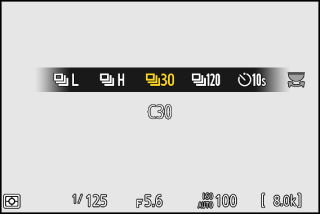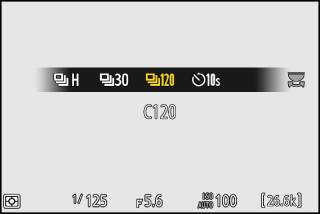Release Mode
Choosing a Release Mode
To choose the operation performed when the shutter-release button is pressed all the
way down, hold the release mode dial lock release and rotate the release mode dial.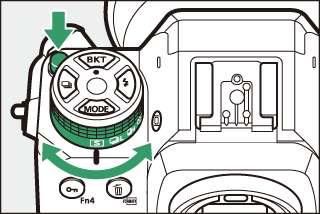
-
Stop when the pointer aligns with the desired setting.
|
Mode |
Description |
|
|---|---|---|
|
U |
Single frame |
The camera takes one photograph each time the shutter-release button is pressed. |
|
V |
Continuous low-speed |
The camera takes photographs at a selected rate while the shutter-release button is pressed.
|
|
W |
Continuous high-speed |
The camera takes photographs at a selected rate while the shutter-release button is pressed. Use for active subjects.
|
|
E |
Self-timer |
Take pictures with the self-timer (Using the Self-Timer (E)). |
|
c |
Quick release-mode selection |
Hold the c button and rotate the main command dial to select the release mode (Quick Release-Mode Selection).
|
-
The frame rates for continuous low-speed and continuous high-speed modes can also be selected using Custom Setting d1 [].
-
The actual frame rate when a frame advance rate of 8 fps is selected in continuous low-speed mode is 7.5 fps.
-
The values given above for frame advance rate assume a focus mode of AF‑C, shooting mode M, a shutter speed of 1/250 s or faster, and default values for all other settings. Frame advance rates may slow:
-
during flash photography,
-
in silent mode,
-
when flicker is detected with [] selected for [] in the photo shooting menu,
-
if aperture is stopped down to a very high f-number, or
-
at slow shutter speeds.
-
-
When [] is selected for [] in the photo shooting menu (Photo Flicker Reduction), the shooting display will briefly go dark during burst photography.
-
Depending on shooting conditions and memory card performance, the memory card access lamp may light for anywhere from a few tens of seconds to around a minute. Do not remove the memory card while the memory card access lamp is lit. Not only could any unrecorded pictures be lost, but the camera or memory card could be damaged.
-
At shutter speeds slower than 1/250 s, the shooting display does not update in real time during burst photography. To track your subject during shooting, choose shutter speeds faster than 1/250 s.
-
If the camera is switched off while the memory card access lamp is lit, it will not power off until all pictures in the buffer have been recorded.
-
If the battery is exhausted while pictures remain in the buffer, the shutter release will be disabled and the pictures transferred to the memory card.
-
While the shutter-release button is pressed halfway, the frame-count display will show the number of pictures that can be stored in the memory buffer.
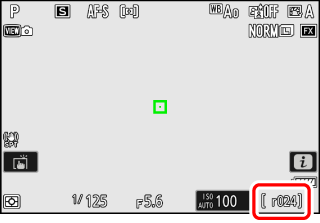
-
When the buffer is full, the display will show r000 and the frame rate will drop.
-
The number shown is approximate. The actual number of photos that can be stored in the memory buffer varies with camera settings and shooting conditions.
Quick Release-Mode Selection
With the release mode dial rotated to c, you can choose a release mode by holding the c button and rotating the main command dial.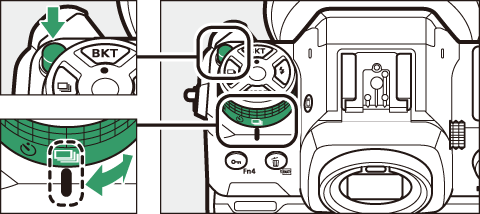
-
Settings for the selected mode can be adjusted by holding the c button and rotating the sub-command dial.
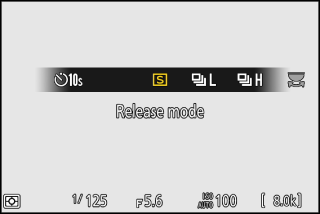
-
High-speed frame capture modes with frame advance rates of 30 or 120 fps are available only when the release mode dial is rotated to c (High-Speed Frame Capture (C30/C120)).
High-Speed Frame Capture (C30/C120)
For high-speed burst photography at frame rates of 30 or 120 fps, set the release
mode dial to c and then hold the c button and rotate the main command dial to choose [] or [].
|
|
|
-
The maximum length for bursts taken in these modes is approximately four seconds.
-
The photos recorded may also include the final pictures from frames buffered while the shutter-release button is pressed halfway (“Pre-Release Capture”); to choose how much of the buffer is saved, use Custom Setting d4 []. You can also limit the length of the burst recorded after the shutter-release button is pressed all the way down (d4: C30/C120 Options).
-
Photos can be taken at the following settings:
Option
C30
C120
Shutter speed
1/32000 to 1/60 s
1/32000 to 1/125 s
[]
[] or []
[] only
[]
[] only
[]
[] only
[] only
-
Pictures are recorded in JPEG format.
-
The upper limit for ISO sensitivity is ISO 25600, even when higher values (Hi 0.3 through Hi 2.0) are selected.
-
The option chosen for [] will not apply if [] is selected for [] > [] in the photo shooting menu.
-
Exposure compensation is restricted to values between −3 and +3 EV, although settings between −5 and +5 EV can be selected.
-
If a DX lens is attached when [] is selected, the release mode will change to [] and image area will be fixed at [].
-
The touch shutter can be used only to take one picture at a time. Use the shutter-release button for high-speed frame capture.
High-speed frame capture cannot be combined with some camera features, including:
-
flexible program,
-
photo flicker reduction,
-
flash photography,
-
bracketing,
-
multiple exposures,
-
HDR overlay,
-
interval-timer photography,
-
time-lapse video recording, and
-
focus shift.
Memory cards with a high write speed are recommended (Approved Memory Cards).
Using the Self-Timer (E)
In self-timer mode, pressing the shutter-release button all the way down starts a timer, and a photo is taken when the timer expires.
-
Rotate the release mode dial to E (self-timer mode).
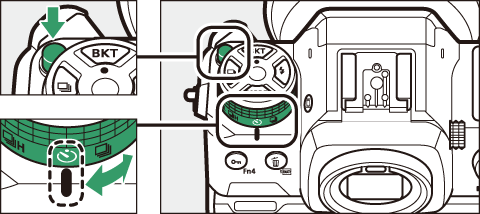
Hold the release mode dial lock release and rotate the release mode dial to E.
-
Frame the photograph and focus.
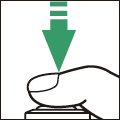
The timer will not start if the shutter cannot be released, as may be the case, for example, if the camera is unable to focus when AF-S is selected for focus mode.
-
Start the timer.
-
Press the shutter-release button all the way down to start the timer; the self-timer lamp will begin to flash. The lamp stops flashing two seconds before the timer expires.
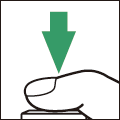
-
To turn the self-timer off before a photograph is taken, rotate the release mode dial to another setting.
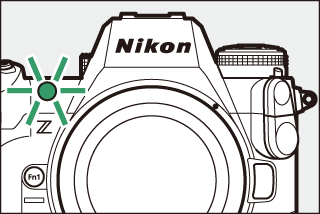
-
The timer duration, the number of shots taken, and the interval between shots can be selected using Custom Setting c2 [].
-
To choose the timer duration, press and hold the c button and rotate a command dial.